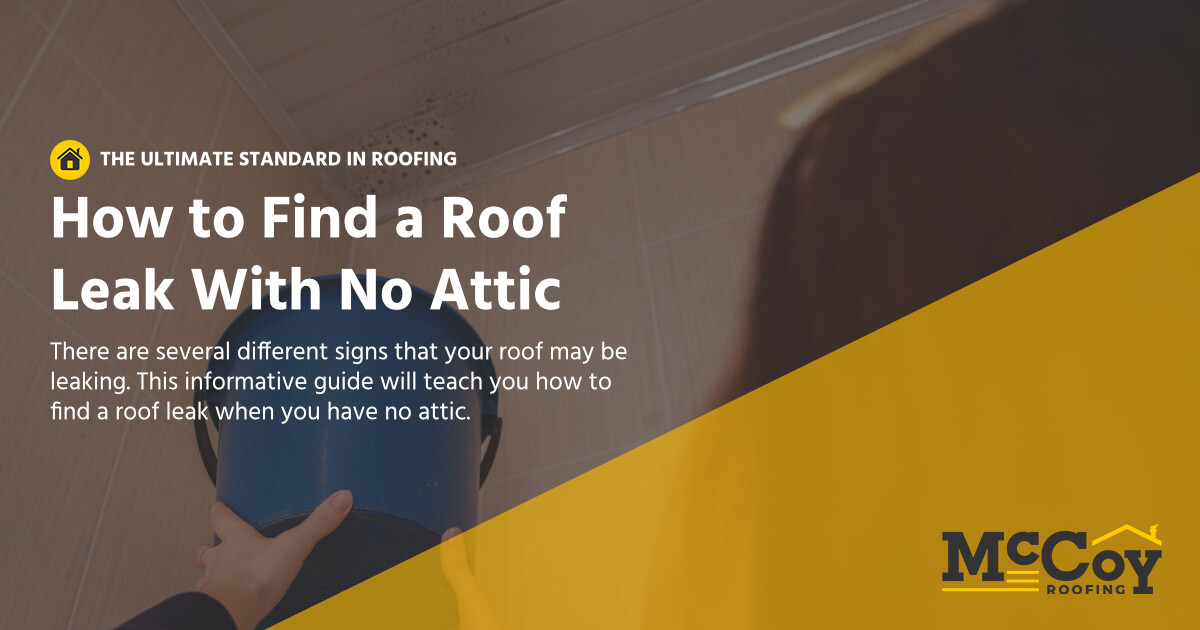

How to Find a Roof Leak With No Attic
There are several different signs that your roof may be leaking. This informative guide will teach you how to find a roof leak when you have no attic.

Little can ruin your home as quietly as a leaky roof. Without an attic to check for leaks, you may go days, weeks, months, and even years without knowing you have a leaky roof.
As your roof slowly leaks, the moisture creates an environment ripe for mold and mold-related illness. Unbeknownst to you, your home and health could slowly begin to deteriorate. When you eventually find out, you’ll be looking at roof repairs that might be more expensive if you don’t catch it early.
It’s not too late, though, to find that leak now and avoid future damage and expense. Keep reading to learn how to find a roof leak when you have no attic. Follow these basic steps for peace of mind.
Finding a Roof Leak
Go High
Begin your investigation by doing a basic roof inspection. If your roof is leaking, you should be able to see some signs on the roof itself. Climb a ladder and follow these basic steps.
Use Caution
Professional roofers are acclimated to the pitch and texture of roofs. Some even wear specialized roofing shoes or boots to prevent slipping and falling.
So, when you start your roof inspection, take great caution to avoid a fall. Do not climb onto the roof without letting someone else know your location. You will need a buddy to find and help you if you fall.
Check Flashing
Start your inspection with the metal flashing. Metal flashing are the thin metal pieces the roofer will install around chimneys and other structures to redirect water away from the roof.
Look specifically for rust or rust stains on or around the flashing. Pry a bit on the flashing to make sure it isn’t loose. If you have loose flashing, you most likely have moisture from precipitation seeping through your ceiling.
If your flashing is loose, you can try to replace it yourself. If you want to ensure the flashing is replaced correctly, call a professional roofer to help you.
Siding and Windows
Once you’ve finished inspecting the roof, look at your siding. Look specifically at the places where the siding meets the roof. Check for visible gaps between the roofing and the siding.
Examine the windows installed in your siding as well. Watch out for gaps or openings on the outsides of the windows. Call a contractor or professional roofer to replace the siding or repair the window and prevent leaks.
Roof Vents
Examine the areas around your roof vents. Pay specific attention to the seals around the vents.
Look for loose or cracked vents. These signs indicate that you may have a leaky roof. Moisture can easily seep into the roof and below through these breaches.
Mold, Mildew, Moss on the Shingles
Pay close attention to the color of the shingles as well. Mold, mildew, and moss all indicate a problem with the roof.
Do you see any black stains or specs on the roof? These coloration changes indicate a serious problem. Moss can damage a roof beyond repair, requiring you to replace the roof altogether.
If you find moss, contact a roofing contractor immediately.
Missing Shingles
You cannot see missing shingles from the ground. So when you step on the roof, look for gaps in the shingles. Some may be missing altogether while others just may have cracks.
Walk across the roof. Does it feel soft? Are the shingles cracking under your feet?
If any of these things are happening, you need a new roof and most likely have a roof and a potentially compromised structure. Your shingles protect your roof, and your roof protects your home. Get new shingles if your shingles are compromised.
Stained Ceiling
When it’s time to look for a leak, start by looking up. A stained ceiling is the smoking gun of residential roofing leaks.
One of the few indicators is a brown spot on your ceiling. It means water is entering from the circular stain to the direction of the long flow of water in the opposite direction.
If your ceiling is an angle on a slope, it will travel from the top of the roof to the bottom. If not fixed within a timely manner, it will eventually move to the side of the wall.
Mold and Mildew
Interior mold and mildew may not manifest itself visually. However, you will be able to smell it.
Follow that smell to its source. You will most likely find an off-colored stain on the ceiling or walls along with a leaky roof.
Bloated Walls
Your leaky ceiling may manifest itself in bloated walls as well. As the roof leaks, moisture seeps into the walls, causing them to swell. Your bloated walls do not indicate a problem with the walls, but rather a problem with your roof.
Check your roof above the wall and see if you notice a leak. Damaged and missing shingles can lead to water in your home, so keep a keen eye out for them. If you don’t see an obvious leak, call in a roof expert to inspect your roof.
Power of Knowing How to Find a Roof Leak When You Have No Attic
Begin by climbing your home and walking around your roof. Look for missing or compromised shingles.
Then move on to your walls. Look for bulging walls and water stains on ceilings. All of these indications will indicate that you have a leaky roof.
Do you need a roofing expert to inspect and repair your roof? Contact McCoy Roofing in Omaha at 402-616-7304 today.
We have the reliable service that will give you peace of mind, whether you need help with a home or a commercial building. We have delivered quality work to satisfied customers for over 10 years. Our refined processes allow us to be both thorough and efficient.
Whether you need a roof repair or a complete roof replacement, we can help you out. Give us a call today for all your roofing and siding needs.